In the spring and summer months in Georgia, when the tanagers and orioles make their way, yellow birds become a common sight, particularly the warblers. However, during the winter season, these vibrant creatures may venture south after breeding in the northern regions.
To assist you in identifying the yellow birds you spot in Georgia, this comprehensive guide offers pictures, identification details, recordings of their melodious songs, and insights into their migratory patterns.
In Georgia, most yellow birds belong to the warbler, oriole, or tanager families. Interestingly, there are occasions where female birds display distinct differences from their male counterparts.
With the wealth of information provided in this guide, identifying yellow birds in Georgia will undoubtedly become a much simpler task. The list of yellow birds is arranged according to their frequency of sightings in the state, as documented in ebird checklists.
Yellow birds present in Georgia throughout the year include the American Goldfinch, Pine Warbler, and Eastern Meadowlark.
During the summer season, the following yellow birds can be found in Georgia: White-eyed Vireo, Common Yellowthroat, Summer Tanager, Yellow-throated Warbler, Hooded Warbler, Yellow-throated Vireo, Scarlet Tanager, Orchard Oriole, Prairie Warbler, Painted Bunting, Black-throated Green Warbler, Prothonotary Warbler, and Dickcissel.
In the winter months, you may come across the Yellow-rumped Warbler, Cedar Waxwing, Palm Warbler, Orange-crowned Warbler, Baltimore Oriole, Western Kingbird, Western Tanager, and Yellow-headed Blackbird.
During migration, the American Redstart, Magnolia Warbler, Cape May Warbler, Yellow Warbler, Blue-winged Warbler, Canada Warbler, Nashville Warbler, and Wilson’s Warbler make appearances in Georgia.
Additionally, there are accidental sightings of yellow birds in Georgia, such as the Evening Grosbeak, Western Meadowlark, Tropical Kingbird, and Scott’s Oriole.
Take this opportunity to read on and learn how to identify the yellow birds you have spotted.
A compilation of 32 Yellow Birds in Georgia:
1. American Goldfinch
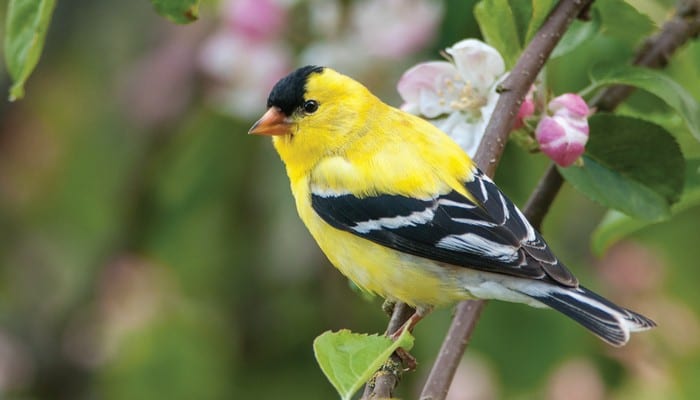
For identification purposes, consider the American Goldfinch. These charming birds can be found in southern Georgia during winter and remain in the northern regions throughout the year. In the state, they have been observed in approximately 22% of summer checklists and 28% of winter checklists submitted by bird enthusiasts.
The males of the American Goldfinch species are particularly captivating with their vibrant yellow and black plumage during the spring season. In contrast, the females exhibit a more subdued brown coloration, similar to the appearance of the males in winter.
Scientific Name: Spinus tristis
Size: 4.3-5.1 inches (11-13 cm)
Weight: 0.4-0.7 ounces (11-20 g)
Wingspan: 7.5-8.7 inches (19-22 cm)
American Goldfinches are commonly found throughout North America and are typically permanent residents. However, those that breed in Canada and the Midwest migrate to the southern states of the US for the winter.
These delightful birds can be spotted foraging in weedy fields and overgrown areas, searching for sunflower, thistle, and aster plants. They are also frequently seen in suburban areas, parks, and even backyard settings.
American Goldfinch Song:
(Recording not available)
When constructing their nests, American Goldfinches prefer shrubs and utilize rootlets and plant materials woven together, firmly secured to branches with spider webs. They lay up to seven eggs, which take approximately two weeks to hatch. The young ones stay in the nest for two to two and a half weeks before venturing out.
To attract American Goldfinches to your backyard, consider planting thistles and milkweed. They are known to visit various bird feeders, with a preference for sunflower and nyjer seeds.
Fun Fact: The vegetarian diet of American Goldfinches poses a challenge for cowbirds, as their chicks cannot survive on such fare and perish within a few days.
2. Pine Warbler
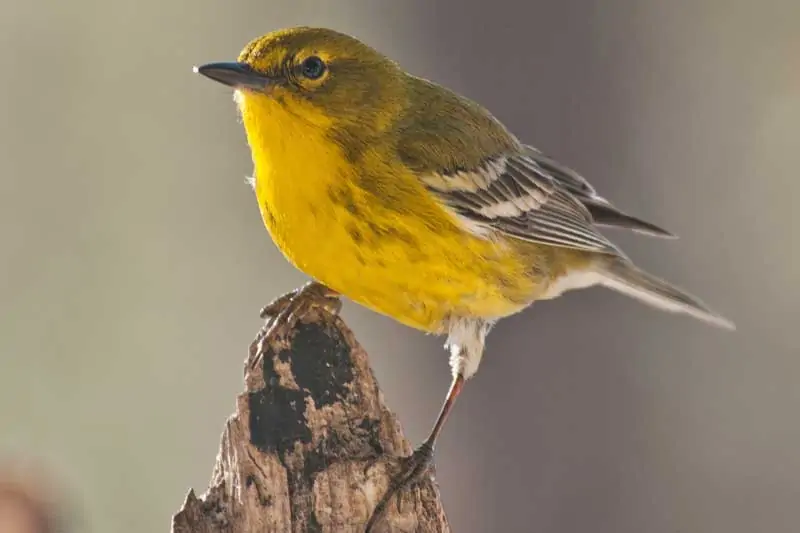
Pine Warblers can be spotted throughout the year in Georgia, with an increased presence during winter, as indicated by their appearance in approximately 17% of summer checklists and 28% of winter checklists compiled by bird enthusiasts.
These plump, small yellow birds have olive backs, white underbellies, and gray wingbars. The female Pine Warblers may exhibit a browner hue and possess more white on their bellies.
Scientific Name: Setophaga pinus
Size: 5.1-5.5 inches (13-14 cm)
Weight: 0.3-0.5 ounces (9-15 g)
Wingspan: 7.5-9.1 inches (19-23 cm)
Pine Warblers breed in the northeastern regions of the United States before making their way to the southeastern states. Some individuals choose to remain in the southeastern states throughout the year.
These delightful birds are commonly found in pine forests, residing in the higher regions of trees. Their diet primarily consists of caterpillars, beetles, spiders, and other insects and larvae. In colder weather, they may also consume fruit and seeds.
Pine Warbler Song:
(Recording not available)
When building their nests, Pine Warblers, as the name suggests, opt for pine trees. The nests are constructed using twigs, bark, pine needles, and grass, held together with spiders’ silk. The interior is lined with feathers and animal hair. Pine Warblers lay up to five eggs, which require approximately two weeks to hatch. The young ones then spend ten additional days in the nest before venturing out.
To attract Pine Warblers to your yard, consider installing tube feeders and platform feeders containing millet, cracked corn, sunflower seeds, peanut hearts, and suet. Additionally, planting native fruits and vines such as bayberry, grape, sumac, and Virginia creeper can enhance their presence.
Fun Fact: Pine Warblers exhibit a unique preference for seeds among warbler species. Consequently, they are more likely to be spotted at backyard feeders.
3. Yellow-rumped Warbler
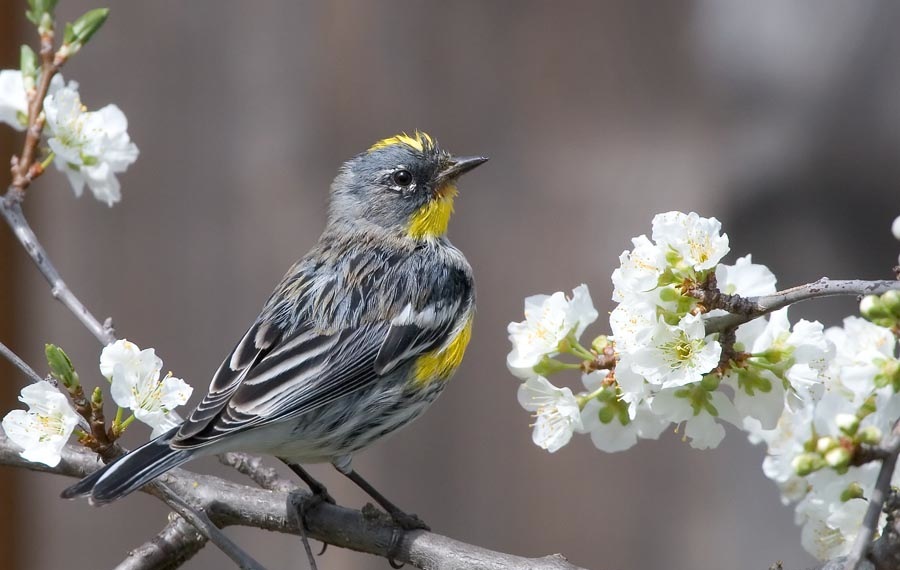
Yellow-rumped Warblers are winter visitors in Georgia, frequently observed from October until May. These birds have been recorded in approximately 31% of winter checklists in the state.
The Yellow-rumped Warbler displays gray plumage with flashes of yellow on the face, sides, and rump. Its wings exhibit a white hue.
Females may possess a slightly brownish coloration, while winter birds appear as paler browns with vibrant yellow rumps and sides. As spring approaches, their colors transition back to yellow and gray.
Scientific Name: Setophaga coronata
Size: 4.7-5.5 inches (12-14 cm)
Weight: 0.4-0.5 ounces (12-13 g)
Wingspan: 7.5-9.1 inches (19-23 cm)
Yellow-rumped Warblers primarily breed in Canada, the Rockies, and the Appalachian mountains. During migration, they can be found in the Midwest. For winter, they migrate to southern and southwestern US states, the Pacific Coast, Mexico, and Central America.
Coniferous forests serve as a preferred habitat for Yellow-rumped Warblers, particularly during
the breeding season. In winter, they can be spotted in open areas with fruiting shrubs. Their diet consists mostly of insects during the summer and migration periods, transitioning to fruit consumption, including bayberry and wax myrtle, during winter.
Yellow-rumped Warbler Song:
(Recording not available)
When it comes to nesting, Yellow-rumped Warblers construct their homes in conifer trees. The nests are composed of twigs, pine needles, grass, and bound together with soft grass, moss, and animal hair. The female lays up to six eggs, with an incubation period of two weeks. The young ones then require an additional two weeks before leaving the nest.
To attract Yellow-rumped Warblers to your backyard, offer sunflower seeds, suet, raisins, and peanut butter.
Fun Fact: Yellow-rumped Warblers often form flocks numbering in the thousands during the winter months. They exhibit aggression toward other species that encroach upon their territory.
4. White-eyed Vireo

White-eyed Vireos spend their breeding season in northern Georgia, primarily observed from March to October. These birds are documented in approximately 16% of summer checklists, with a few individuals remaining in the southern regions of the state throughout the year.
White-eyed Vireos possess gray heads with yellow tones around their foreheads and distinctive white eyes. They exhibit white chests and throats, along with yellow sides. Their backs display a greenish hue, complemented by darker wings and two white wingbars.
Scientific Name: Vireo griseus
Size: 4.3-5.1 inches (11-13 cm)
Weight: 0.3-0.5 ounces (10-14 g)
Wingspan: 6.7 inches (17 cm)
During the summer, White-eyed Vireos can be found breeding across the southeastern United States, often concealed within dense thickets. Certain populations remain year-round along the coast. For the winter season, they migrate to the southeastern coast of Mexico and the Caribbean.
These vireos frequent overgrown pastures and brambles, where they feed on insects, flies, and spiders. In winter, their diet expands to include berries.
White-eyed Vireo Song:
(Recording not available)
Nests of White-eyed Vireos are suspended from branches in shrubs. The initial structure is woven using spider webs, which are then adorned with leaves, bark, and plant material. These nests house up to four eggs, requiring around twelve days for incubation and an additional ten days for the young ones to leave the nest.
To attract White-eyed Vireos to your backyard, provide ample dense vegetation and native plants to attract insects.
Fun Fact: During the winter, both male and female White-eyed Vireos sing. However, during the spring and summer, only the males showcase their vocal prowess, engaging in continuous singing from dawn until noon.
5. Common Yellowthroat
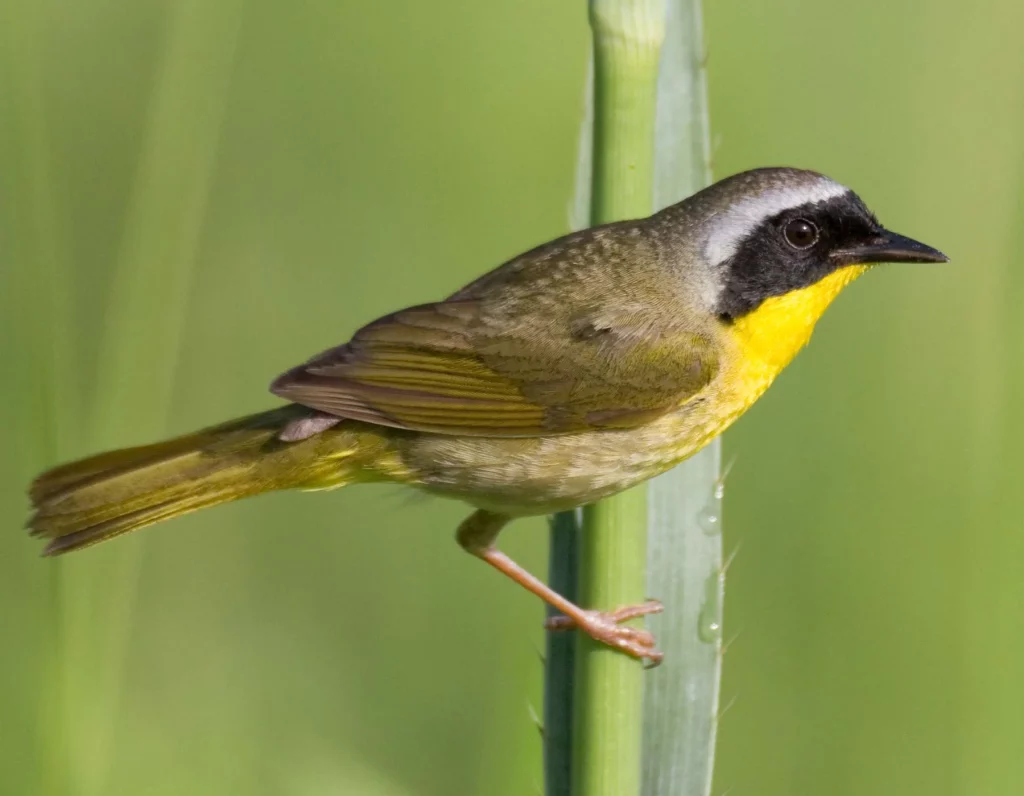
Common Yellowthroats can be spotted in southern Georgia throughout the year, with a higher occurrence in the northern regions during the breeding season. They are documented in approximately 12% of summer checklists and 2% of winter checklists in the state.
These small songbirds boast brownish backs and vibrant yellow undersides, accompanied by long tails. Male Common Yellowthroats exhibit black masks across their faces. The intensity of their yellow plumage may vary geographically, with some populations displaying a more olive hue on the undersides.
Scientific Name: Geothlypis trichas
Size: 4.3-5.1 inches (11-13 cm)
Weight: 0.3-0.3 ounces (9-10 g)
Wingspan: 5.9-7.5 inches (15-19 cm)
Common Yellowthroats breed throughout most of North America, excluding Alaska and northern Canada. Some individuals remain year-round along the Gulf Coast and Pacific Southwest, while others migrate south for the winter.
These delightful birds often inhabit marshy or wetland areas, as well as brushy fields with dense vegetation.
Common Yellowthroat Song:
(Recording not available)
Nests of Common Yellowthroats are constructed by females near the ground in marshy areas, utilizing reeds for support. The nests are composed of grass and sedges, forming a cup-shaped structure supported by leaves and grass. They lay up to six eggs, requiring around twelve days for incubation, followed by an additional ten days for the young ones to leave the nest.
To attract Common Yellowthroats to larger backyards, cultivate dense vegetation and native plants that entice insects.
Fun Fact: The black mask displayed by male Common Yellowthroats serves as a signal to courting males, warning them to keep their distance. Interestingly, they do not display aggression toward decoy birds without masks.
6. Cedar Waxwing
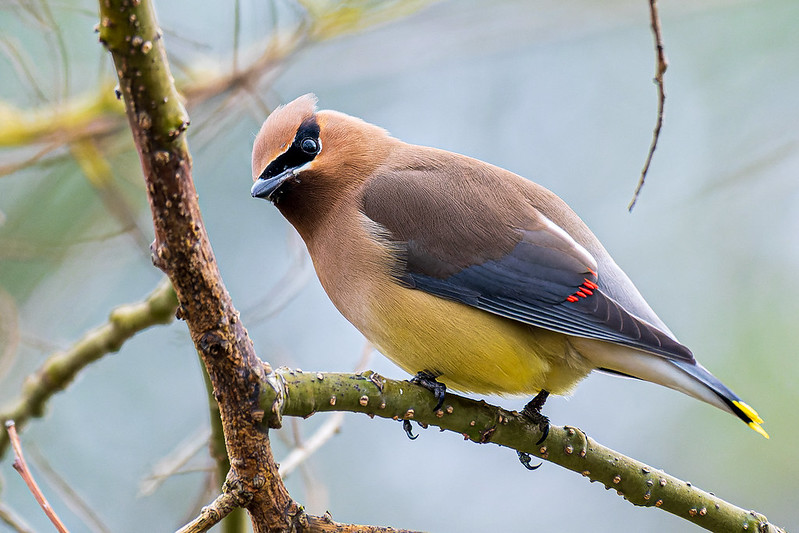
Cedar Waxwings are primarily observed in Georgia during the winter months, accounting for approximately 9% of checklists during this period. They are typically seen in the state from November to May, with certain individuals choosing to remain in the northern regions throughout the year.
These elegant and sociable birds exhibit pale brown heads, chests, and crests, transitioning to a gray hue on their backs, wings, and tail. Their bellies display a pale yellow shade, complemented by bright yellow tips on their wings. Notably, they possess narrow black masks across their eyes and sport bright red wingtips.
Scientific Name: Bombycilla cedrorum
Size: 5.5-6.7 inches (14-17 cm)
Weight: 1.1 ounces (32 g)
Wingspan: 8.7-11.8 inches (22-30 cm)
Cedar Waxwings breed in Canada before migrating to the southern United States, Mexico, and Central America for the winter season. In northern US states, they remain year-round.
These delightful birds can be found in berry bushes, woodlands, grasslands, towns, and along streams. While their diet primarily consists of fruit, they also consume insects during the summer months.
Cedar Waxwing Call:
(Recording not available)
Nests of Cedar Waxwings are constructed in trees using twigs, grass, hair, and plant material. The interiors are lined with pine needles and soft grass. They lay up to six eggs, which require around twelve days to hatch. The young ones then spend approximately sixteen days in the nest before venturing out.
To attract Cedar Waxwings to your backyard, consider planting native trees and shrubs that bear small fruits, such as serviceberry, dogwood, juniper, winterberry, and hawthorn. Additionally, try offering fruit on platform feeders.
Fun Fact: Cedar Waxwings engage in a unique behavior when courting potential mates—they exchange gifts, passing them back and forth between individuals.
7. Palm Warbler
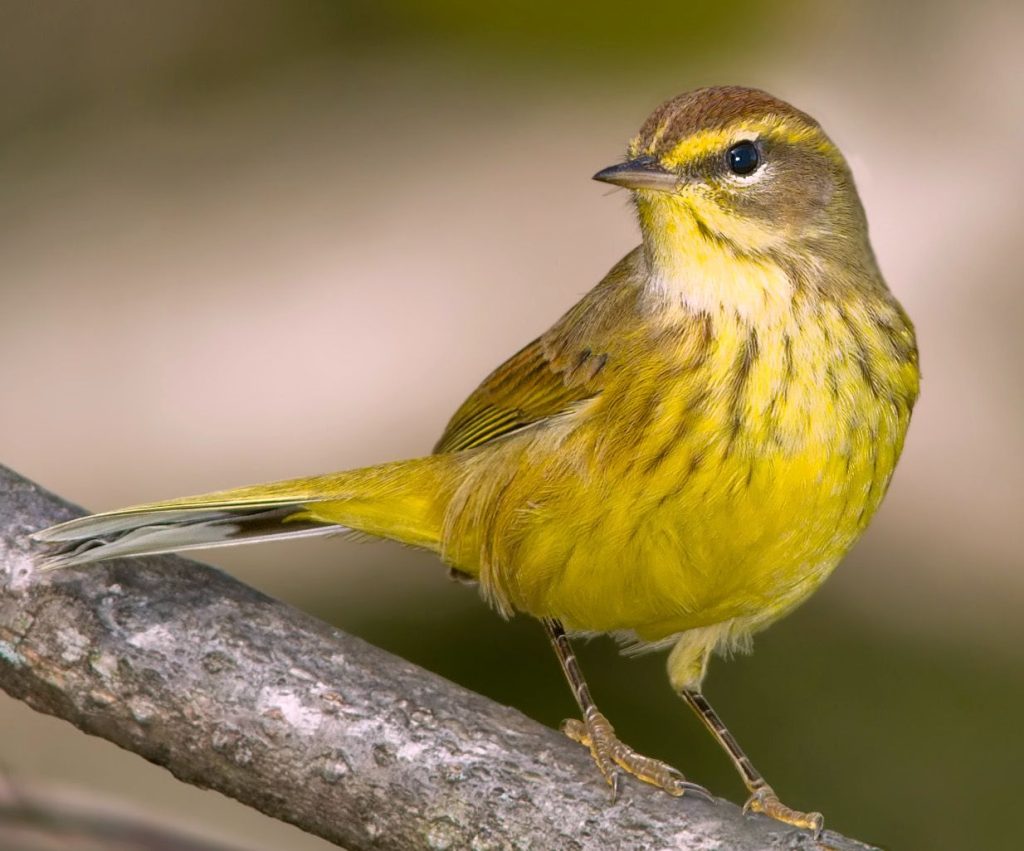
Palm Warblers can be observed in Georgia during the winter months, with their numbers increasing during the migration periods in April and October. They are documented in approximately 5% of winter checklists and up to 20% of checklists during migration.
These warblers possess rusty red patches on the tops of their heads and exhibit a brownish-olive coloration across the rest of their bodies. While they breed in Canada, they can be found in eastern states during migration, as well as in Florida and along the far southern coast throughout the year.
Scientific Name: Setophaga palmarum
Size: 4.7-5.5 inches (12-14 cm)
Weight: 0.3-0.5 ounces (7-13 g)
Wingspan: 7.9-8.3 inches (20-21 cm)
Palm Warblers predominantly breed in Canada and make appearances during migration in eastern US states. Some individuals choose to spend the winter in Florida and along the southeastern coast.
These warblers are commonly spotted in weedy fields, forest edges, and scrubby areas during the spring and fall migrations. They often forage on the ground for insects, mingling with other bird species like sparrows, juncos, and yellow-rumped warblers.
Palm Warbler Song:
(Recording not available)
Nests of Palm Warblers are typically found in bogs and boreal forests, constructed on the ground. They are composed of grass, sedge, and ferns woven into a cup shape, lined with soft grass, feathers, and animal hair. Palm Warblers lay approximately five eggs.
To attract Palm Warblers to your backyard, consider planting native plants that attract insects. Additionally, introduce bayberry or hawthorn plants that produce berries.
Fun Fact: Unlike most warbler species, Palm Warblers are known for walking on the ground and bobbing their tails while in search of insects.
8. Summer Tanager Female

Summer Tanagers are frequently spotted in Georgia during the breeding season, spanning from April to October. They are documented in approximately 14% of checklists during this period.
Male Summer Tanagers are characterized by their vibrant red plumage and robust beaks. In contrast, females and juveniles display predominantly yellow hues with hints of green on their backs.
Scientific Name: Piranga rubra
Size: 6.7 inches (17 cm)
Weight: 1.1 ounces (30 g)
Summer Tanagers breed in southern and eastern US states before embarking on their winter migration to Central and South America.
These birds prefer open woodlands as their habitat and feed on bees and wasps mid-flight. They catch and kill their prey by striking it against a branch, effectively removing the stinger before consumption.
Summer Tanager Song:
(Recording not available)
Nests of Summer Tanagers are constructed by females using grass and other plant materials. These nests are typically situated towards the end of overhanging branches. Although not the most intricately constructed, they hold around four eggs. The incubation period lasts approximately ten days, and it takes the young ones another ten days to leave the nest.
To attract Summer Tanagers to your backyard, consider cultivating berry bushes and fruit trees.
Fun Fact: Young Scarlet Tanagers receive parental care for an additional three weeks after leaving the nest, as their flying abilities are not fully developed.
9. Eastern Meadowlark

Eastern Meadowlarks, classified as a near-threatened species, can be observed throughout the year in Georgia, appearing in around 4% of both summer and winter checklists.
These medium-sized songbirds feature bright yellow undersides and pale brown backs, adorned with distinctive black markings. A black band across the chest adds to their unique appearance.
Scientific Name: Sturnella magna
Size: 7.5-10.2 inches (19-26 cm)
Weight: 3.2-5.3 ounces (90-150 g)
Wingspan: 13.8-15.8 inches (35-40 cm)
Eastern Meadowlarks can be found across eastern US states throughout the year, with additional breeding populations in the Northeast and Canada. They migrate south during the winter season.
The arrival of spring is often heralded by the melodious singing and displays of Eastern Meadowlarks, although their near-threatened status is a matter of concern.
These birds primarily inhabit grasslands and prairies, foraging on insects. During winter, they gather in large flocks in fields, searching for seeds.
Eastern Meadowlark Sounds:
(Recording not available)
Nests of Eastern Meadowlarks exhibit remarkable construction, incorporating tunnels and roofs made from woven grasses. They lay their eggs in these nests and utilize them for breeding purposes.
Fun Fact: Eastern Meadowlarks are known to produce more than 100 different songs.
10. Yellow-throated Warbler

While some Yellow-throated Warblers can be observed throughout the year, they are more commonly spotted in Georgia during the breeding season, featuring in approximately 5% of summer checklists.
These warblers exhibit gray and white plumage with black stripes, accompanied by vibrant yellow throats. From below, they showcase white bellies and tails. Females and juveniles possess paler coloration.
Scientific Name: Setophaga dominica
Size: 5.1-5.5 inches (13-14 cm)
Weight: 0.3-0.4 ounces (9-11 g)
Wingspan: 8.3 inches (21 cm)
Yellow-throated Warblers primarily breed across the southeastern US states and spend their winters in Florida, the Caribbean, and along the Gulf Coast, extending into Central America. Some individuals may remain resident year-round in Florida.
These warblers are typically found at the tops of pine trees, foraging for insects. However, during migration, they may venture to lower levels.
Yellow-throated Warbler Song:
(Recording not available)
Nests of Yellow-throated Warblers are woven into Spanish moss, suspended from tree branches. These nests are constructed from grasses, weeds, and moss, forming a cup-like structure. They lay approximately four eggs, with an incubation period of two weeks.
To attract Yellow-throated Warblers to your backyard, create a habitat with native plants and preserve wild and unmanicured areas.
Fun Fact: Yellow-throated Warblers have experienced a population increase in recent years, bucking the declining trend observed earlier. Since 1966, their numbers have grown by 50%.
11. Hooded Warbler

Hooded Warblers are predominantly seen in Georgia during the breeding season, appearing in approximately 8% of summer checklists.
These warblers possess striking black hoods that contrast with their bright yellow faces, throats, and upper bodies. The rest of their plumage is olive-green, and they exhibit white in their outer tail feathers.
Scientific Name: Setophaga citrina
Size: 4.3-5.1 inches (11-13 cm)
Weight: 0.3-0.4 ounces (9-11 g)
Wingspan: 7.5-8.3 inches (19-21 cm)
Hooded Warblers breed across the eastern United States, from the Midwest to the Atlantic Coast, and winter in Central America.
These warblers are typically found in dense understory vegetation within forests, often near water sources. They feed on insects, spiders, and small invertebrates.
Hooded Warbler Song:
(Recording not available)
Nests of Hooded Warblers are built on or near the ground, usually hidden amidst vegetation. They are cup-shaped and constructed from leaves, grass, and bark fibers. Hooded Warblers lay around four eggs, with an incubation period of approximately 12 days.
To attract Hooded Warblers to your backyard, create suitable habitat with dense shrubs and trees and provide a water source.
Fun Fact: Male Hooded Warblers perform a unique fluttering display, spreading their wings to expose the bright yellow feathers while singing to attract females.
12. Yellow-throated Vireo

Yellow-throated Vireos can be observed in Georgia during the breeding season, featuring in approximately 4% of summer checklists.
These vireos exhibit bright yellow throats and upper bodies, contrasting with their olive-green backs and wings. They have distinct white wingbars.
Scientific Name: Vireo flavifrons
Size: 5.9 inches (15 cm)
Weight: 0.6-0.7 ounces (17-20 g)
Wingspan: 9.4-10.2 inches (24-26 cm)
Yellow-throated Vireos breed across the eastern United States, from the Great Lakes region to the Gulf Coast, and spend winters in Mexico and Central America.
They prefer mature deciduous forests, where they forage for insects and spiders among the foliage. Their slender beaks allow them to extract prey from leaves and branches.
Yellow-throated Vireo Song:
(Recording not available)
Nests of Yellow-throated Vireos are suspended from the forked branches of trees, usually positioned near the end of a horizontal limb. They are made from bark strips, plant fibers, and spider silk, forming a cup-shaped structure. These vireos lay around three eggs.
To attract Yellow-throated Vireos to your backyard, maintain a diverse forested habitat with mature trees and provide a water source.
Fun Fact: Yellow-throated Vireos are known for their continuous and rapid singing, with males often delivering over 100 songs per minute.
13. Scarlet Tanager
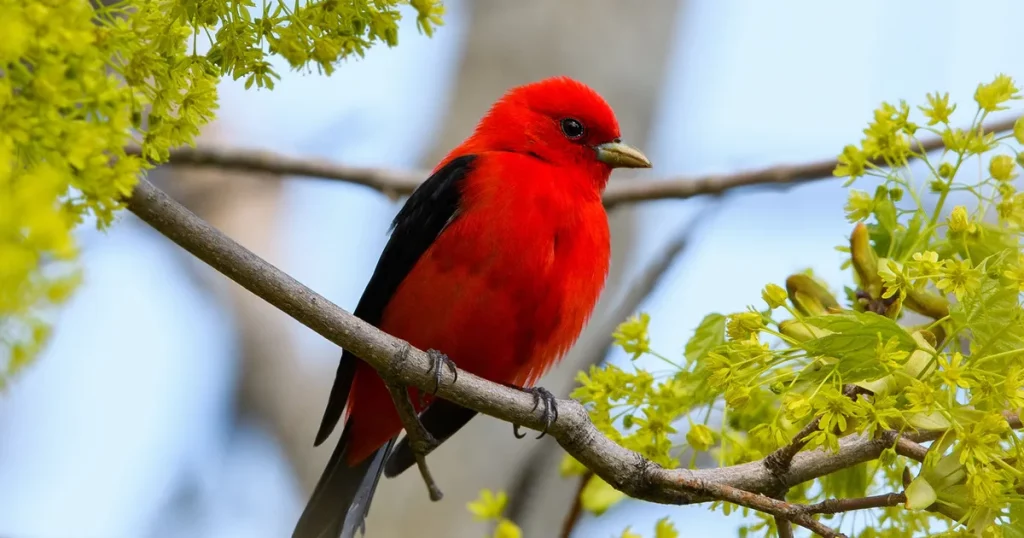
Scarlet Tanagers are frequently observed in Georgia during the breeding season, appearing in approximately 12% of summer checklists.
Male Scarlet Tanagers exhibit brilliant red plumage, which contrasts with their black wings and tails. Females, on the other hand, showcase olive-yellow upperparts and yellowish underparts.
Scientific Name: Piranga olivacea
Size: 6.3-7.1 inches (16-18 cm)
Weight: 0.9-1.2 ounces (25-34 g)
Wingspan: 9.8-10.6 inches (25-27 cm)
Scarlet Tanagers breed across the eastern United States and parts of Canada, migrating to South America for winter.
These birds inhabit deciduous and mixed forests, where they forage for insects and fruit. They are known for their aerial foraging, snatching insects mid-air.
Scarlet Tanager Song:
(Recording not available)
Nests of Scarlet Tanagers are typically built on horizontal branches, located high in mature trees. They construct cup-shaped nests using twigs, leaves, and bark fibers, lined with softer materials such as grass and hair. Scarlet Tanagers lay around three to four eggs.
To attract Scarlet Tanagers to your backyard, provide a diverse forested habitat with tall trees, shrubs, and fruit-bearing plants.
Fun Fact: Male Scarlet Tanagers undergo a molt after breeding, transitioning to a duller plumage similar to that of the females, which aids in camouflage during migration.
14. Orchard Oriole

Orchard Orioles are commonly spotted in Georgia during the breeding season, featuring in approximately 9% of summer checklists.
Male Orchard Orioles exhibit vibrant chestnut plumage on their heads, necks, and upper bodies, contrasting with their black wings and tails. Females showcase olive-green upperparts and yellowish underparts.
Scientific Name: Icterus spurius
Size: 6.3-7.1 inches (16-18 cm)
Weight: 0.6-0.9 ounces (17-25 g)
Wingspan: 8.7-9.4 inches (22-24 cm)
Orchard Orioles breed across the eastern and central United States, migrating to Mexico, Central America, and northern South America for winter.
These orioles frequent open woodlands, orchards, and suburban areas, where they feed on insects, nectar, and fruit. They are often found among the canopy of trees.
Orchard Oriole Song:
(Recording not available)
Nests of Orchard Orioles are intricately woven, hanging from the tips of slender branches, usually near the ends of the outer canopy. They construct pouch-like nests using grass, plant fibers, and other materials, incorporating spider silk for flexibility. Orchard Orioles lay around three to four eggs.
To attract Orchard Orioles to your backyard, provide fruit feeders, nectar feeders, and nesting materials such as yarn or string.
Fun Fact: Orchard Orioles have a unique foraging technique called “gleaning,” where they glean insects from leaves and branches rather than actively hunting on the wing.
15. Prairie Warbler
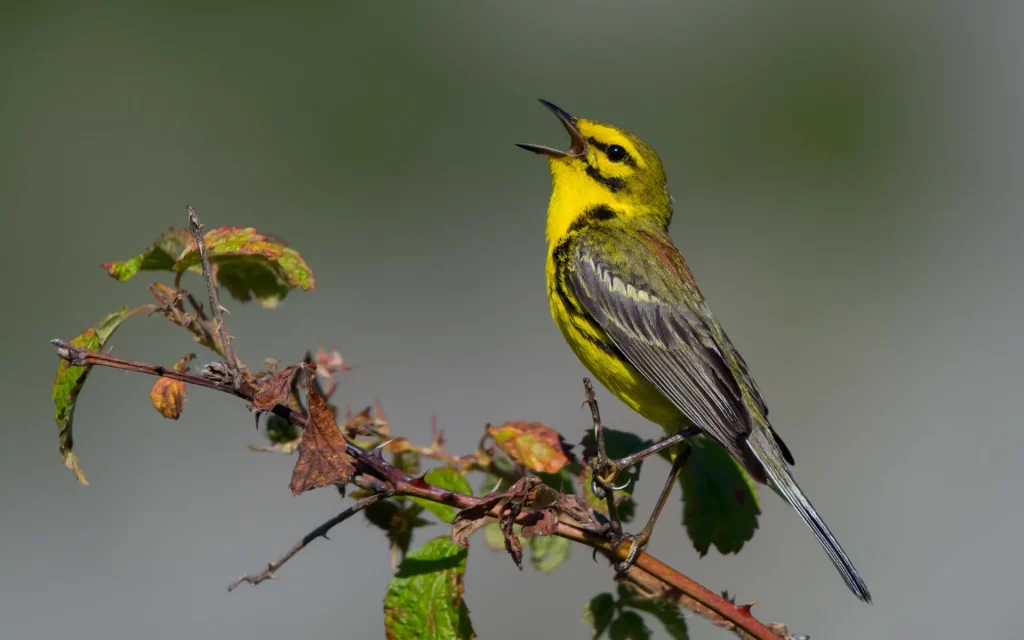
Prairie Warblers are frequently observed in Georgia during the breeding season, appearing in approximately 10% of summer checklists.
These warblers exhibit bright yellow plumage with bold black streaks on their sides and backs. Males showcase chestnut-colored streaks on their upper breasts, while females exhibit paler streaking.
Scientific Name: Setophaga discolor
Size: 4.3-5.1 inches (11-13 cm)
Weight: 0.3-0.4 ounces (9-11 g)
Wingspan: 6.7-7.5 inches (17-19 cm)
Prairie Warblers breed across the eastern United States, from the Great Lakes region to the Gulf Coast, and spend winters in the Caribbean and Central America.
These warblers inhabit shrubby areas, grasslands, and open woodlands, where they forage for insects among the vegetation. They are known for their energetic and active foraging behavior.
Prairie Warbler Song:
(Recording not available)
Nests of Prairie Warblers are constructed in dense shrubs or low trees, typically close to the ground. They are cup-shaped structures made from grasses, leaves, and bark fibers, lined with finer materials such as plant down and hair. Prairie Warblers lay around four to six eggs.
To attract Prairie Warblers to your backyard, maintain shrubby habitats with native plants and provide a water source.
Fun Fact: Prairie Warblers have a distinctive “chip” call that sounds like a coin being flipped in the air.
16. Painted Bunting
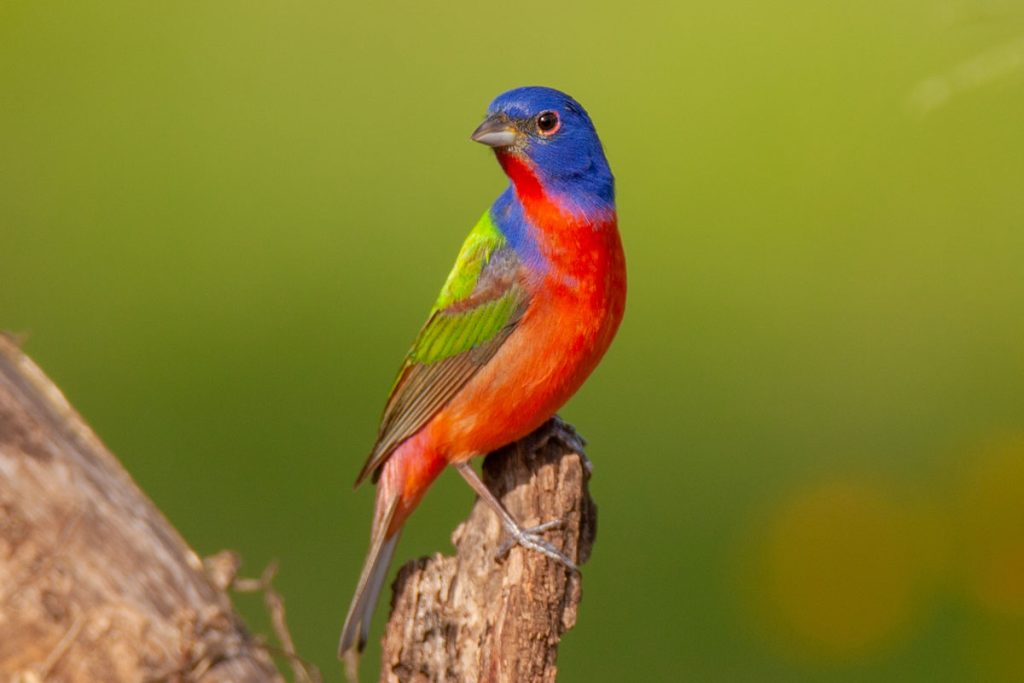
Painted Buntings are occasionally seen in Georgia during the breeding season, featuring in less than 1% of summer checklists.
Male Painted Buntings are known for their vibrant plumage, showcasing blue heads, green backs, and red underparts. Females, however, exhibit predominantly green plumage with yellowish underparts.
Scientific Name: Passerina ciris
Size: 4.7 inches (12 cm)
Weight: 0.6 ounces (17 g)
Wingspan: 7.1 inches (18 cm)
Painted Buntings breed in the southeastern United States and migrate to Mexico and Central America for winter.
These buntings prefer brushy habitats, including shrubby edges, thickets, and secondary growth areas. They feed on seeds, fruits, and insects.
Painted Bunting Song:
(Recording not available)
Nests of Painted Buntings are often hidden within dense shrubs or low vegetation, constructed from grasses, leaves, and fine plant fibers. They lay around three to four eggs.
To attract Painted Buntings to your backyard, provide dense shrubs and bushes for cover and offer a variety of seeds and fruits in feeders.
Fun Fact: Male Painted Buntings undergo a molt after breeding, replacing their vibrant plumage with duller colors similar to females, helping them camouflage during migration and winter.
17. Black-throated Green Warbler
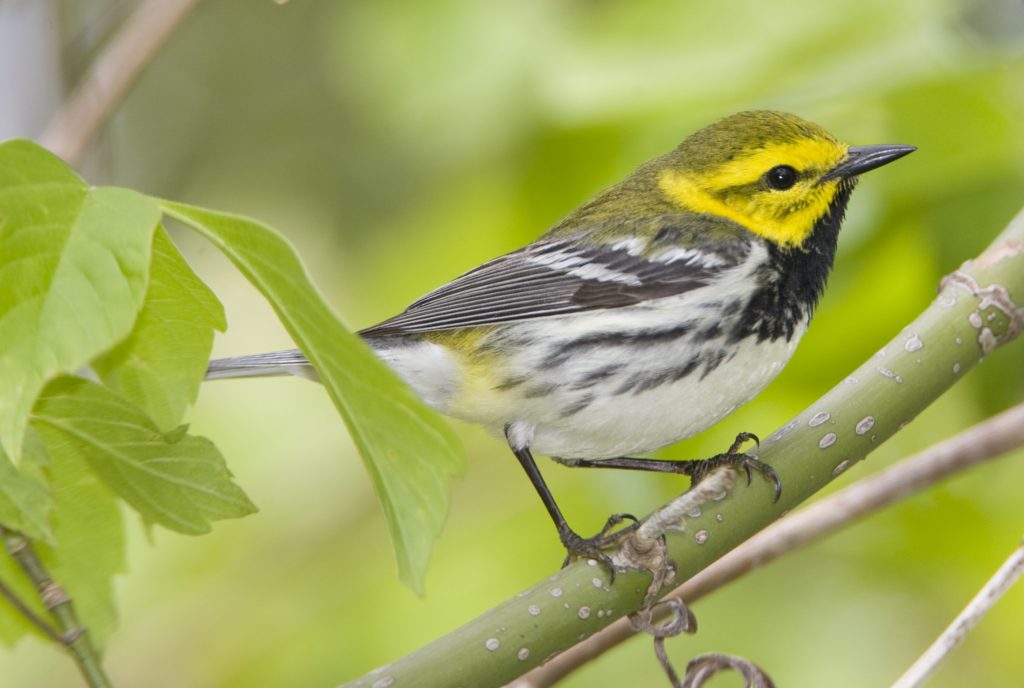
Black-throated Green Warblers can be spotted in Georgia during migration, appearing in approximately 6% of checklists during that time.
These warblers have olive-green upperparts and bright yellow underparts. Males have a black throat and face, while females exhibit more subdued coloring.
Scientific Name: Setophaga virens
Size: 4.7-5.1 inches (12-13 cm)
Weight: 0.3-0.4 ounces (9-11 g)
Wingspan: 7.5-8.7 inches (19-22 cm)
Black-throated Green Warblers breed in northeastern United States and parts of Canada, and they migrate through eastern and central states during spring and fall.
These warblers prefer coniferous and mixed forests, where they forage for insects among the tree branches. They are known for their acrobatic foraging behavior.
Black-throated Green Warbler Song:
(Recording not available)
Nests of Black-throated Green Warblers are typically constructed in conifer trees, situated near the end of a branch. They are cup-shaped structures made from twigs, bark strips, and lichens, lined with softer materials such as plant down and feathers. Black-throated Green Warblers lay around four eggs.
To attract Black-throated Green Warblers during migration, provide a variety of trees and shrubs that offer food sources and cover.
Fun Fact: Black-throated Green Warblers have a unique vocalization referred to as the “trees-are-moving” song, which sounds like a rising, buzzy trill.
18. Prothonotary Warbler
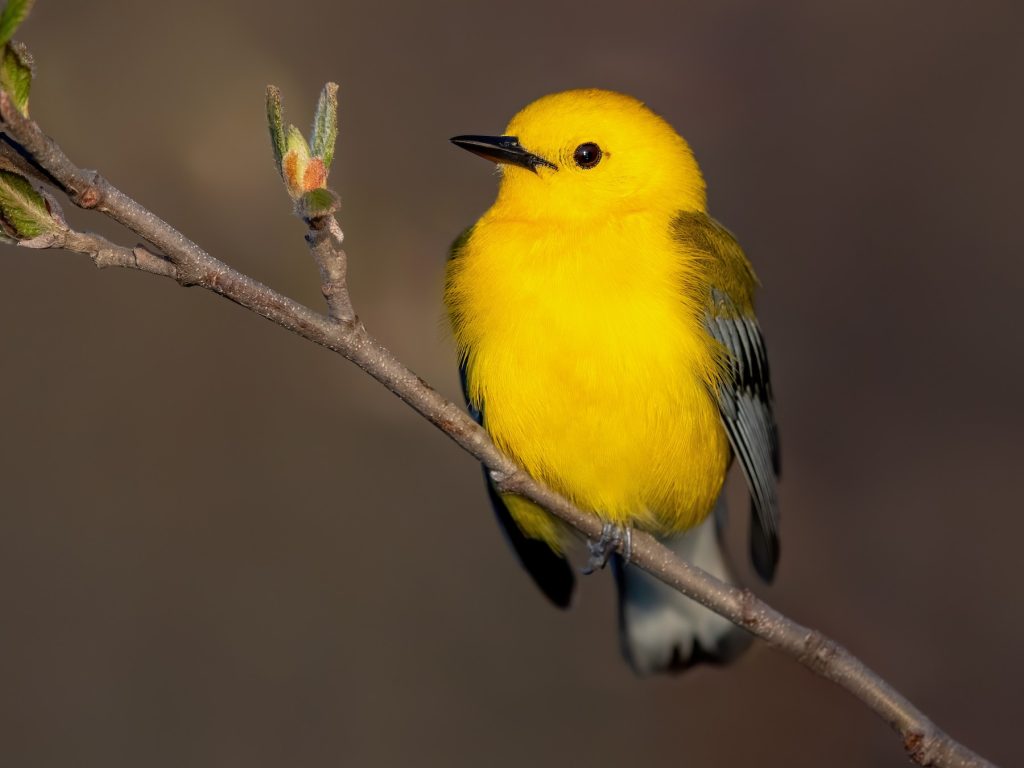
Prothonotary Warblers can be observed in Georgia during migration, appearing in approximately 4% of checklists during that time.
These warblers display bright yellow plumage with bluish-gray wings and tails. Males have a prominent orange crown, while females exhibit a paler crown.
Scientific Name: Protonotaria citrea
Size: 4.3-5.1 inches (11-13 cm)
Weight: 0.3-0.4 ounces (9-11 g)
Wingspan: 7.1-7.5 inches (18-19 cm)
Prothonotary Warblers breed in the eastern United States, particularly in swampy areas, and migrate through eastern and central states during spring and fall.
These warblers inhabit bottomland forests, wetlands, and wooded swamps, where they forage for insects near the water’s edge. They may also use nest boxes.
Prothonotary Warbler Song:
(Recording not available)
Nests of Prothonotary Warblers are typically built in tree cavities or nest boxes, usually near water sources. They construct cup-shaped nests using moss, leaves, and bark fibers, lined with softer materials such as plant down. Prothonotary Warblers lay around four to seven eggs.
To attract Prothonotary Warblers during migration, provide nest boxes near water sources and maintain suitable habitat with wetland vegetation.
Fun Fact: Prothonotary Warblers are the only eastern warblers that nest in natural or artificial cavities rather than building open cup-shaped nests.
19. Dickcissel

Dickcissels are occasionally seen in Georgia during migration, appearing in less than 1% of checklists during that time.
These birds have a stout bill and display a mix of yellow and brown plumage. Males exhibit a distinct black bib on their throats.
Scientific Name: Spiza americana
Size: 5.5-6.3 inches (14-16 cm)
Weight: 1-1.3 ounces (28-37 g)
Wingspan: 9.1-9.8 inches (23-25 cm)
Dickcissels breed in the central United States and parts of Canada, and they migrate through the central and southeastern states during spring and fall.
These birds prefer grasslands, prairies, and agricultural fields, where they forage on seeds, insects, and grasshoppers.
Dickcissel Song:
(Recording not available)
Nests of Dickcissels are typically built on the ground, hidden within vegetation. They construct cup-shaped nests using grasses, stems, and leaves, lined with finer materials such as plant down and hair. Dickcissels lay around three to five eggs.
To potentially spot Dickcissels during migration, explore open grassy areas and fields where they are known to congregate.
Fun Fact: Dickcissels are known for their distinctive song, which consists of a series of buzzes followed by a sharp, metallic “dick-dick-ciss-ciss.”
20. American Redstart
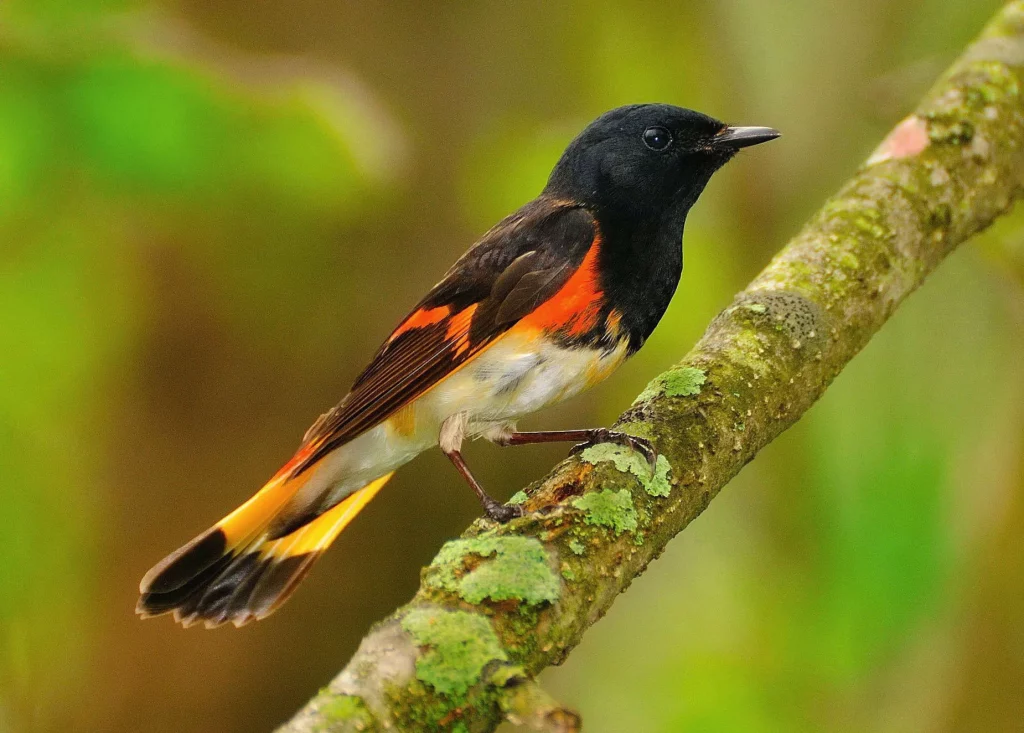
American Redstarts can be spotted in Georgia during migration, appearing in approximately 7% of checklists during that time.
These warblers exhibit a striking plumage pattern, with black upperparts, bright orange patches on their sides, wings, and tails, and white underparts.
Scientific Name: Setophaga ruticilla
Size: 4.3-5.1 inches (11-13 cm)
Weight: 0.3-0.4 ounces (9-11 g)
Wingspan: 7.5-8.7 inches (19-22 cm)
American Redstarts breed in the northeastern United States and parts of Canada, migrating through eastern and central states during spring and fall.
These warblers inhabit various forest habitats, including deciduous and mixed forests, where they forage by actively gleaning insects from foliage and making quick, fluttering flights to catch prey.
American Redstart Song:
(Recording not available)
Nests of American Redstarts are cup-shaped structures, typically situated near the end of a tree branch. They are constructed using bark strips, plant fibers, and other materials, often incorporating spider silk for flexibility. American Redstarts lay around three to five eggs.
To potentially observe American Redstarts during migration, explore wooded areas with dense vegetation and listen for their distinctive song.
Fun Fact: Male American Redstarts are known for their unique “flash and fly” foraging behavior, where they rapidly fan their tails and wings to startle insects, making them easier to catch.
21. Magnolia Warbler

Magnolia Warblers can be observed in Georgia during migration, appearing in approximately 8% of checklists during that time.
These warblers showcase a distinctive plumage pattern, with black streaking on their yellow underparts and a prominent white eye-ring. Males have a black band across their chest.
Scientific Name: Setophaga magnolia
Size: 4.7-5.1 inches (12-13 cm)
Weight: 0.3-0.4 ounces (9-11 g)
Wingspan: 7.5-8.7 inches (19-22 cm)
Magnolia Warblers breed in the boreal forests of Canada and Alaska, migrating through eastern and central states during spring and fall.
These warblers prefer a variety of habitats, including coniferous and mixed forests, where they forage for insects among the foliage. They are known for their active and acrobatic foraging behavior.
Magnolia Warbler Song:
(Recording not available)
Nests of Magnolia Warblers are usually built on or near the ground in dense vegetation, such as shrubs or small trees. They construct cup-shaped nests using grasses, bark, and other plant materials, lined with softer materials such as plant down. Magnolia Warblers lay around four to five eggs.
To potentially spot Magnolia Warblers during migration, explore wooded areas with ample foliage and listen for their high-pitched, musical song.
Fun Fact: The name “Magnolia Warbler” was given to this species by Alexander Wilson, an early American ornithologist, who named it after the magnolia-like pattern on its plumage.
22. Cape May Warbler
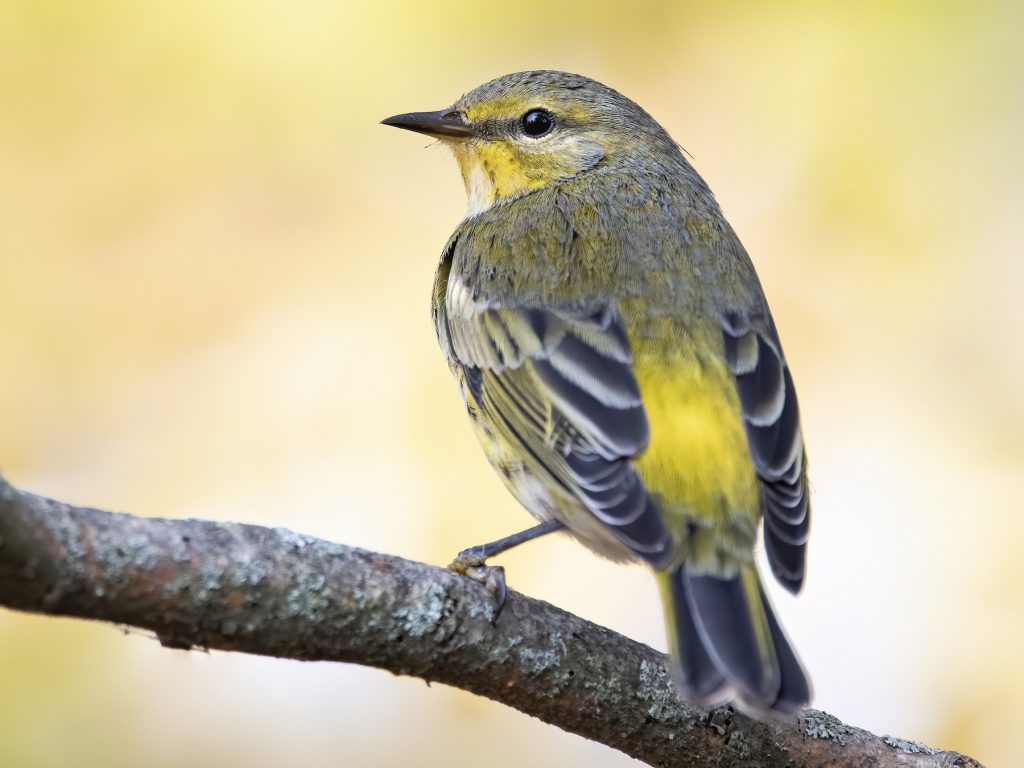
Cape May Warblers can be spotted in Georgia during migration, appearing in approximately 5% of checklists during that time.
These warblers exhibit a mix of yellow, olive-green, and chestnut plumage, with distinctive chestnut cheek patches and a yellow rump.
Scientific Name: Setophaga tigrina
Size: 4.3-5.1 inches (11-13 cm)
Weight: 0.3-0.4 ounces (9-11 g)
Wingspan: 7.5-8.7 inches (19-22 cm)
Cape May Warblers breed in the boreal forests of North America, primarily in Canada, and migrate through eastern and central states during spring and fall.
These warblers inhabit a variety of forested habitats, including coniferous forests and spruce bogs, where they forage for insects by probing and gleaning among the branches.
Cape May Warbler Song:
(Recording not available)
Nests of Cape May Warblers are typically constructed in conifer trees, situated high up near the trunk or in a forked branch. They are cup-shaped structures made from twigs, grasses, and plant fibers, lined with softer materials such as feathers and hair. Cape May Warblers lay around four to five eggs.
To potentially observe Cape May Warblers during migration, explore forested areas with coniferous trees and listen for their high-pitched, buzzy song.
Fun Fact: The Cape May Warbler is known for its unique feeding behavior, in which it extracts nectar from flowers by piercing the base of the flower with its sharp beak, allowing it to access the sugary liquid.
23. Yellow Warbler
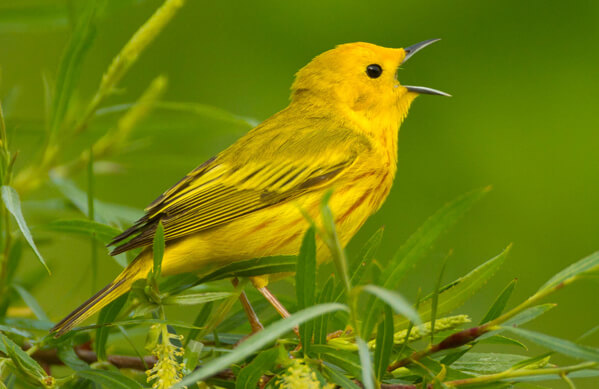
Yellow Warblers can be observed in Georgia during migration, appearing in approximately 11% of checklists during that time.
These warblers are primarily bright yellow with reddish-brown streaking on their breasts and a splash of rusty color on their caps.
Scientific Name: Setophaga petechia
Size: 4.7 inches (12 cm)
Weight: 0.3-0.4 ounces (9-11 g)
Wingspan: 6.7-7.5 inches (17-19 cm)
Yellow Warblers breed across much of North America, including parts of Canada and the United States, and migrate through various states during spring and fall.
These warblers inhabit a variety of habitats, including forests, wetlands, and shrubby areas, where they forage for insects by actively gleaning and flitting through foliage.
Yellow Warbler Song:
(Recording not available)
Nests of Yellow Warblers are typically constructed in shrubs or small trees, close to the ground or near water sources. They are cup-shaped structures made from grasses, plant fibers, and other materials, often woven tightly with spider silk. Yellow Warblers lay around three to five eggs.
To potentially spot Yellow Warblers during migration, explore areas with dense vegetation and listen for their sweet, melodic song.
Fun Fact: Yellow Warblers are known to engage in a behavior called “extra-pair mating,” where both males and females may mate with multiple partners outside their breeding pairs.
24. Blue-winged Warbler
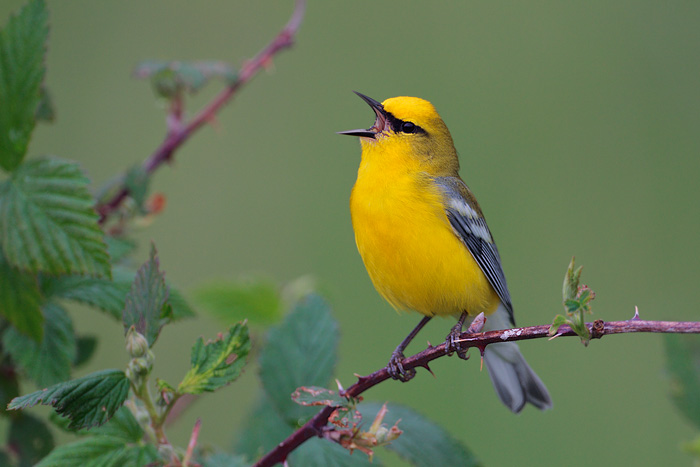
Blue-winged Warblers can be spotted in Georgia during migration, appearing in approximately 6% of checklists during that time.
These warblers showcase yellow plumage with a distinct blue-gray patch on their wings and a white wingbar.
Scientific Name: Vermivora cyanoptera
Size: 4.7-5.1 inches (12-13 cm)
Weight: 0.3-0.4 ounces (9-11 g)
Wingspan: 7.5-8.7 inches (19-22 cm)
Blue-winged Warblers breed in the eastern United States, primarily in the Midwest and parts of the Southeast, and migrate through various states during spring and fall.
These warblers inhabit a variety of habitats, including open woodlands, shrubby areas, and early-successional habitats, where they forage for insects by gleaning and actively searching for prey.
Blue-winged Warbler Song:
(Recording not available)
Nests of Blue-winged Warblers are typically constructed on or near the ground, often in fields or shrubby areas. They build cup-shaped nests using grasses, leaves, and bark strips, lined with finer materials such as plant down. Blue-winged Warblers lay around four to six eggs.
To potentially observe Blue-winged Warblers during migration, explore mixed woodland habitats with a mixture of open spaces and shrubby vegetation.
Fun Fact: Blue-winged Warblers sometimes hybridize with Golden-winged Warblers, producing hybrid offspring known as “Brewster’s Warblers” or “Lawrence’s Warblers,” which display a mix of characteristics from both parent species.
25. Canada Warbler
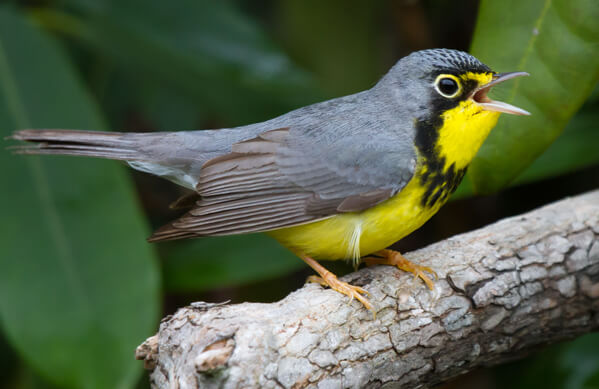
Canada Warblers can be observed in Georgia during migration, appearing in approximately 5% of checklists during that time.
These warblers exhibit a grayish-blue back, yellow underparts, and a distinct necklace of black streaking across their yellow throats.
Scientific Name: Cardellina canadensis
Size: 4.7-5.1 inches (12-13 cm)
Weight: 0.3-0.4 ounces (9-11 g)
Wingspan: 7.1-8.7 inches (18-22 cm)
Canada Warblers breed in boreal forests across Canada and migrate through various states during spring and fall, primarily along the eastern side of North America.
These warblers inhabit dense, shrubby understory habitats in forests, often near water sources, where they forage for insects by actively searching and hopping along the ground.
Canada Warbler Song:
(Recording not available)
Nests of Canada Warblers are typically built on or near the ground, hidden within dense vegetation such as moss or ferns. They construct cup-shaped nests using grasses, leaves, and other plant materials, often incorporating fine moss or lichens. Canada Warblers lay around four to five eggs.
To potentially spot Canada Warblers during migration, explore forested areas with dense understory vegetation and listen for their high, clear song.
Fun Fact: Canada Warblers are known for their unique migration route, with individuals traveling over 2,500 miles (4,000 km) from their breeding grounds in Canada to their wintering grounds in northern South America.
26. Nashville Warbler
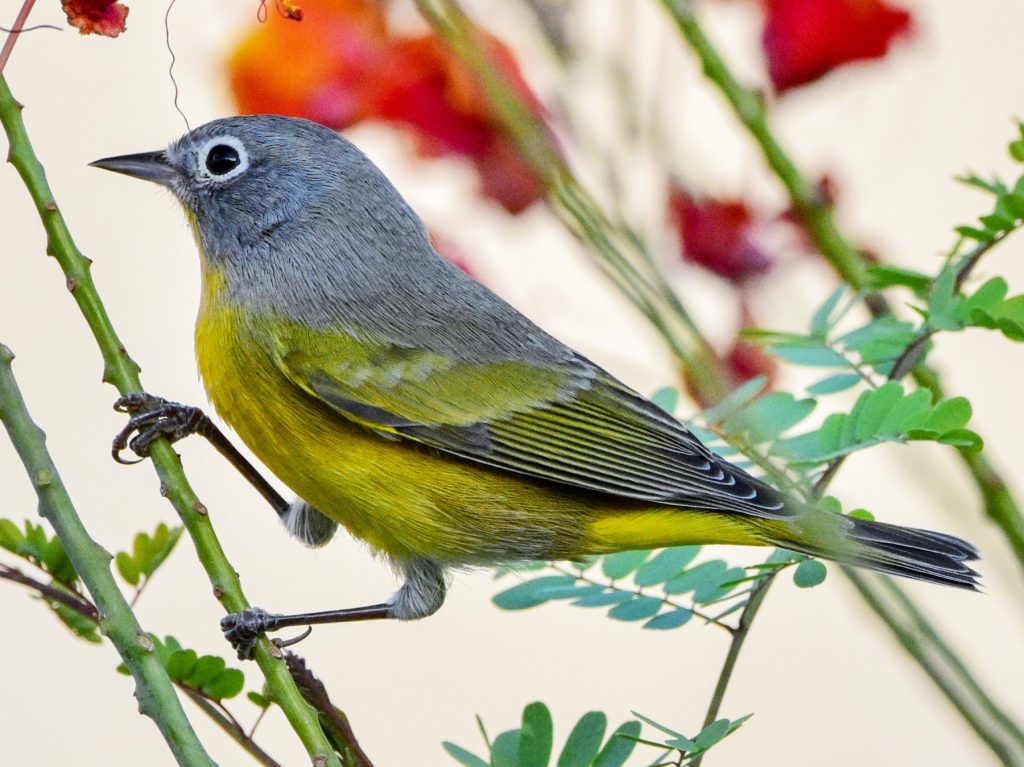
Nashville Warblers can be spotted in Georgia during migration, appearing in approximately 5% of checklists during that time.
These warblers exhibit yellow underparts, grayish-olive upperparts, and a distinct white eye-ring.
Scientific Name: Leiothlypis ruficapilla
Size: 4.3-5.1 inches (11-13 cm)
Weight: 0.3-0.4 ounces (9-11 g)
Wingspan: 6.7-7.5 inches (17-19 cm)
Nashville Warblers breed in the boreal forests of Canada and parts of the northeastern United States, migrating through various states during spring and fall.
These warblers inhabit a variety of habitats, including mixed forests, open woodlands, and shrubby areas, where they forage for insects by actively gleaning and flitting through foliage.
Nashville Warbler Song:
(Recording not available)
Nests of Nashville Warblers are typically constructed on or near the ground, hidden within dense vegetation such as grass or shrubs. They build cup-shaped nests using grasses, moss, and other plant materials, lined with softer materials such as plant down. Nashville Warblers lay around three to five eggs.
To potentially observe Nashville Warblers during migration, explore areas with a mix of deciduous and coniferous trees, as well as dense understory vegetation.
Fun Fact: Nashville Warblers were named after the city of Nashville, Tennessee, where the species was first collected and described by naturalist Alexander Wilson in 1811.
27. Wilson’s Warbler
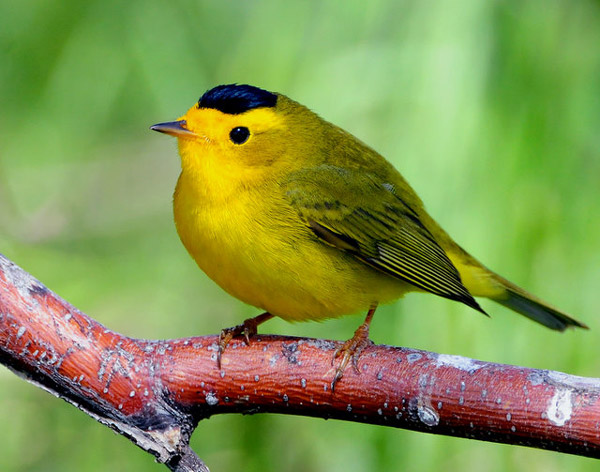
Wilson’s Warblers can be observed in Georgia during migration, appearing in approximately 9% of checklists during that time.
These warblers exhibit bright yellow plumage with olive-green upperparts, a black cap, and a distinctive black bib on their throats.
Scientific Name: Cardellina pusilla
Size: 4.7-5.1 inches (12-13 cm)
Weight: 0.3-0.4 ounces (9-11 g)
Wingspan: 7.1-7.9 inches (18-20 cm)
Wilson’s Warblers breed in western North America, primarily in Canada and Alaska, and migrate through various states during spring and fall.
These warblers inhabit a variety of habitats, including shrubby areas, wetlands, and forest edges, where they forage for insects by actively searching through foliage and vegetation.
Wilson’s Warbler Song:
(Recording not available)
Nests of Wilson’s Warblers are typically constructed on or near the ground, hidden within dense vegetation such as grass or shrubs. They build cup-shaped nests using grasses, moss, and other plant materials, lined with softer materials such as feathers and animal hair. Wilson’s Warblers lay around four to five eggs.
To potentially spot Wilson’s Warblers during migration, explore areas with dense vegetation, especially near water sources, and listen for their rapid, high-pitched song.
Fun Fact: Wilson’s Warblers are known for their unique tail-wagging behavior, where they constantly flick their tails up and down while foraging and singing.
28. Evening Grosbeak
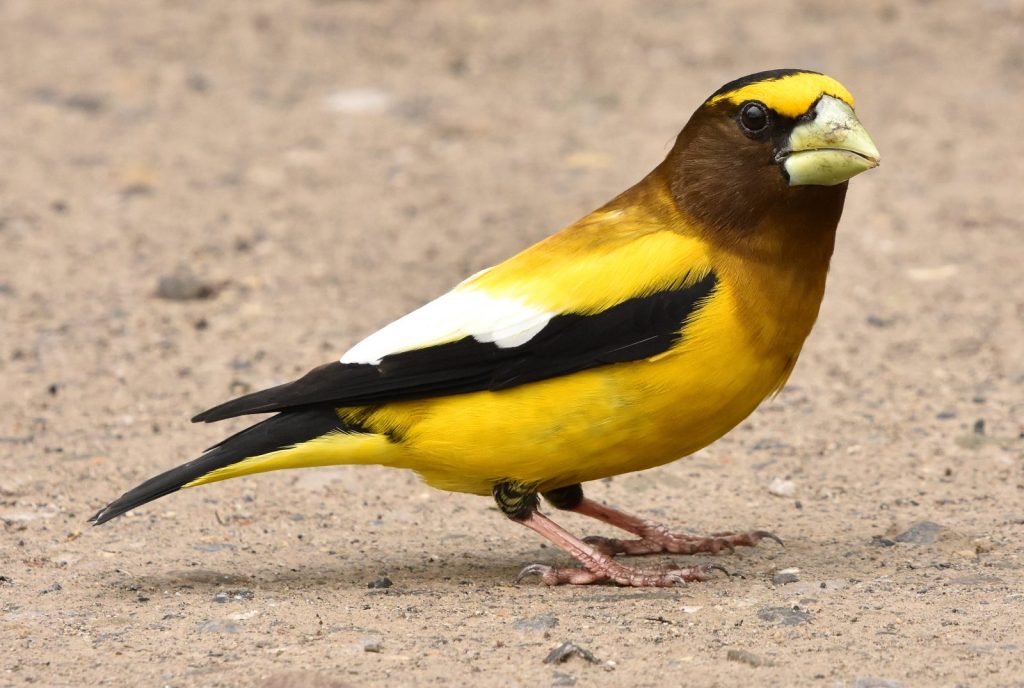
Evening Grosbeaks are considered accidental visitors to Georgia, rarely seen in the state.
These birds are large, chunky finches with a distinctive color pattern. They display yellow plumage on their bodies, black wings with white patches, and a large, thick beak.
Scientific Name: Coccothraustes vespertinus
Size: 6.7-8.7 inches (17-22 cm)
Weight: 1.6-2.3 ounces (45-65 g)
Wingspan: 12.2-13.4 inches (31-34 cm)
Evening Grosbeaks are native to the western parts of North America but occasionally undertake irregular irruptions, leading to their appearance outside their typical range.
These finches inhabit coniferous forests and mountainous areas, where they feed on seeds, fruits, and buds. They may visit bird feeders, especially during winter when food sources are scarce.
Evening Grosbeak Call:
(Recording not available)
Nests of Evening Grosbeaks are usually located high in conifer trees, constructed from twigs, bark, and grasses, lined with finer materials such as rootlets and hair. Evening Grosbeaks lay around three to four eggs.
To potentially spot Evening Grosbeaks in Georgia, it would require a rare occurrence during their irregular movements outside their normal range.
Fun Fact: Evening Grosbeaks have a strong preference for seeds from boxelder trees, which are toxic to most other bird species but do not affect them.
29. Western Meadowlark

Western Meadowlarks are not commonly seen in Georgia and are considered accidental visitors to the state.
These birds are medium-sized with a stocky build and showcase a bright yellow breast with black V-shaped markings. They have a brown back with streaks and a long, pointed bill.
Scientific Name: Sturnella neglecta
Size: 7.1-10.2 inches (18-26 cm)
Weight: 3.9-6.3 ounces (110-180 g)
Wingspan: 14-16.5 inches (36-42 cm)
Western Meadowlarks are native to western North America and prefer grassland habitats, including fields, meadows, and prairies, where they forage for insects and seeds.
Their distinct song, often described as a melodious flute-like whistling, can be heard during the breeding season.
Western Meadowlark Song:
(Recording not available)
Nests of Western Meadowlarks are constructed on the ground in grassy areas, usually concealed within a clump of vegetation or near a shrub. They build cup-shaped nests using grasses and lined with finer materials such as hair or feathers. Western Meadowlarks lay around three to six eggs.
While rare in Georgia, to potentially spot Western Meadowlarks, explore open grassland habitats or large fields during migration periods or keep an eye out for sightings reported by birdwatchers.
Fun Fact: Western Meadowlarks are the state bird of six U.S. states: Kansas, Montana, Nebraska, North Dakota, Oregon, and Wyoming.
30. Tropical Kingbird
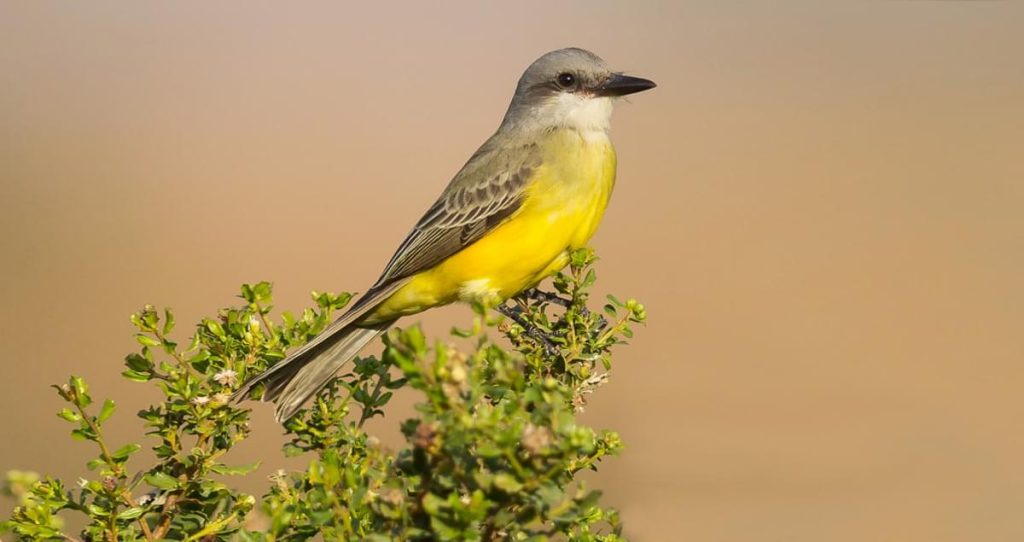
Tropical Kingbirds are considered accidental visitors to Georgia and are rarely seen in the state.
These birds belong to the flycatcher family and have a large head, long tail, and a sturdy bill. They exhibit olive-gray upperparts, a yellow throat, and a white belly.
Scientific Name: Tyrannus melancholicus
Size: 8.3-9.1 inches (21-23 cm)
Weight: 1.3-1.6 ounces (37-46 g)
Wingspan: 15.4-16.1 inches (39-41 cm)
Tropical Kingbirds are native to the tropical regions of the Americas and are known for their aerial acrobatics as they catch insects in mid-air.
These kingbirds inhabit a variety of habitats, including open woodlands, forest edges, and urban areas with trees, where they forage for insects and occasionally consume fruits.
Tropical Kingbird Call:
(Recording not available)
Nests of Tropical Kingbirds are typically built in the forks of trees, constructed from twigs, plant fibers, and other materials, often lined with softer materials such as feathers or moss. They lay around three to four eggs.
While rare in Georgia, to potentially spot Tropical Kingbirds, keep an eye out for sightings reported by experienced birdwatchers, especially in habitats with mature trees and abundant insect activity.
Fun Fact: Tropical Kingbirds are known for their aggressive nature and will defend their nesting territories by dive-bombing and chasing away larger birds or even mammals that venture too close.
31. Scott’s Oriole

Scott’s Orioles are considered accidental visitors to Georgia and are rarely seen in the state.
These birds are medium-sized orioles with striking plumage. Males have bright yellow underparts, black heads, and black wings with white wingbars. Females are duller with more olive-brown plumage.
Scientific Name: Icterus parisorum
Size: 7.1-7.9 inches (18-20 cm)
Weight: 0.8-1.2 ounces (23-34 g)
Wingspan: 12.2-13.4 inches (31-34 cm)
Scott’s Orioles breed in the southwestern United States and northern Mexico, primarily in arid habitats such as deserts and semi-open areas with scattered trees or cacti.
These orioles are known for their melodious songs, which they use to establish territories and attract mates.
Scott’s Oriole Song:
(Recording not available)
Nests of Scott’s Orioles are typically constructed in tall trees, using grasses, plant fibers, and other materials, often weaving them into a pouch-like structure. They lay around three to five eggs.
While rare in Georgia, to potentially spot Scott’s Orioles, explore areas with scattered trees or shrubs, especially during migration periods, or stay updated on birdwatcher reports.
Fun Fact: Scott’s Orioles are known for their preference for palm trees, where they often build their nests and feed on the insects attracted to the trees’ flowers.
32. Hooded Warbler
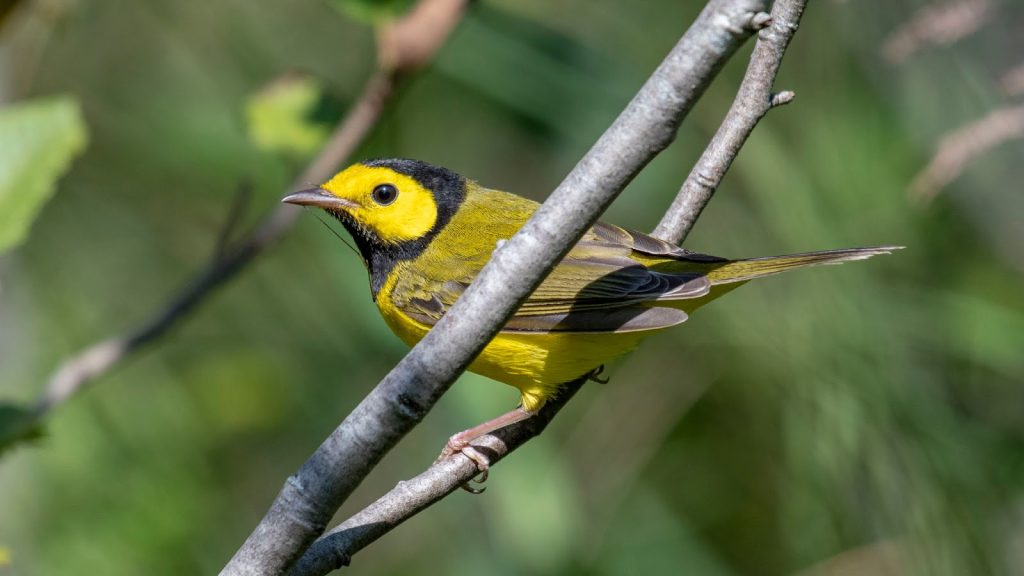
Hooded Warblers can be spotted in Georgia during the summer breeding season, appearing in approximately 13% of checklists during that time.
These warblers showcase vibrant yellow plumage with a black hood-like marking on their heads. The female Hooded Warblers have a duller appearance with olive-green tones.
Scientific Name: Setophaga citrina
Size: 4.3-5.1 inches (11-13 cm)
Weight: 0.3-0.4 ounces (9-11 g)
Wingspan: 7.5-8.7 inches (19-22 cm)
Hooded Warblers breed in the eastern United States and parts of the Midwest before migrating to their wintering grounds in Central America.
These warblers prefer dense understory habitats in deciduous or mixed forests, where they forage for insects by gleaning and actively searching through leaves and branches.
Hooded Warbler Song:
(Recording not available)
Nests of Hooded Warblers are typically built on or near the ground, concealed in leaf litter or vegetation. They construct cup-shaped nests using grasses, leaves, and plant fibers, often lined with finer materials such as moss or hair. Hooded Warblers lay around three to five eggs.
To potentially observe Hooded Warblers during the breeding season, explore wooded areas with dense understory vegetation and listen for their distinct song.
Fun Fact: Hooded Warblers are known for their unique foraging behavior called “leaf-flipping,” where they use their bill to flip over leaves to uncover hidden insects.
And there you have it, a list of 32 yellow birds that can be found in Georgia! Whether you’re a bird enthusiast or simply enjoy observing nature’s beauty, keep your eyes and ears open for these colorful feathered visitors in the diverse habitats of Georgia.